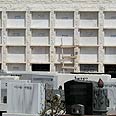
A group of ultra-Orthodox men held a demonstration outside the auditorium, claiming that the innovative method contradicts Halacha and is "not Jewish burial". The move was blasted by haredi media as well.
In the Jerusalem conference, Religious Services Ministry officials explained to heads of the Chevra Kadisha burial services that the wide public had gotten used to field burial and was finding it difficult to see its loved ones buried in the different "dense burial" methods following the shortage of burial spaces.
In the coming weeks, Israelis will be exposed to a television, radio, newspaper and Internet campaign aimed at convincing them that this type of burial is halachically permitted and is not considered desecration of the dead.
"People have yet to internalize this possibility, which is considered innovative and nontraditional," said Ministry Director-General Ohana. "In this campaign we'll prove the opposite."
According to Ohana, dense burial is not being funded by the Finance Ministry, forcing Chevra Kadisha companies to do so from their income from field burial. As this income is slowly decreasing, he called on the State to take part in the funding.
"This campaign is in favor of the citizens," said Minister Margi. "Before the funeral emotions are high, and decision making is irrational."
He added that Israel was running out of burial spaces, causing field burial prices to soar.
The minister took the opportunity to deny claims that women are being excluded from cemeteries by not being allowed to eulogize or escort their loved ones to their graves.
"If someone wants to blame this problem on Chevra Kadisha, he is doing wrong to them, to the public and to the concept of 'exclusion of women," he said. "We instruct Chevra Kadisha to be attentive to the families' needs, and this is done even when they go to extremes with their demands."
The conference attendees were presented with televised comments by Israel's Chief Rabbis Yona Metzger and Shlomo Amar, in which they sought to prove that dense burial was halachically permitted.
Chief Rabbinate Council Member Rabbi Yaakov Roje, considered an expert on the issue, elaborated on dense burial using halachic rulings written by senior rabbinical authorities from all generations.
The Religious Services Ministry is referring to the method as "Sanhedrin burial", implying that many of the greatest sages of Israel were buried in the same way.
Not everyone in favor
But not everyone in the haredi public was convinced. The Yated Ne'eman newspaper, considered the Lithuanian rabbinical leadership's mouthpiece, published an extensive report on the issue over the weekend.
Under the headline, "Reform in burial services," the newspaper reported of "an attempt to change the old field burial custom with dense burial in levels and niches, in complete violation of the Halacha."
According to the haredi newspaper, the ministry's campaign is expected to include 'false and distorted halachic rulings in the name of the greatest sages of Israel, while all sages and rabbinical authorities were strictly against any change in the burial custom."
Rabbi Gedaliah Axelrod, president of a Haifa rabbinical court, who protested with the group of haredim outside the conference, told Ynet: "We failed to find any 'genius element' in the fact that graves are being pushed into buildings and niches – this never happened when there was a space shortage in Europe."
According to the rabbi, there is enough land in the State of Israel to bury all the deceased in the field burial method, but the government is avoiding it.
The protestors held signs reading, "Multi-level burial is not Jewish burial," and Rabbi Axelrod explained that Rabbi Ovadia Yosef was almost the only prominent religious authority to allow it. "(Moses) Mendelson was wrong too, and he is the father of Reform Judaism," he said. "I'm not saying Rabbi Ovadia is Reform, but he is wrong."
Axelrod added that the burial mitzvah was the Torah's most important command, and therefore he had to defend it: "It's customary to ask the deceased for forgiveness after the burial, but today Chevra Kadisha is doing it a moment after placing them in a pool of cement.
"I don’t blame the religious services minister as I don't expect him to be familiar with the religious rules, but I do blame rabbis who permit such a thing."















